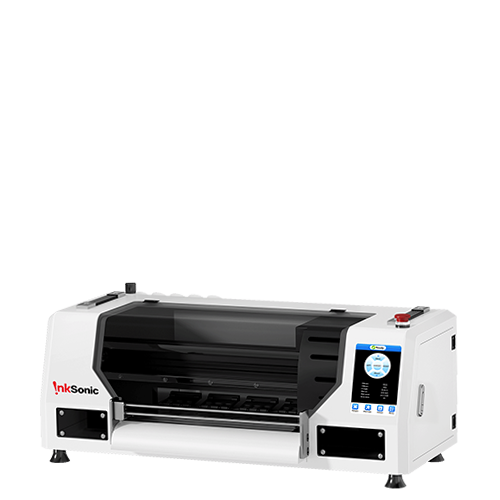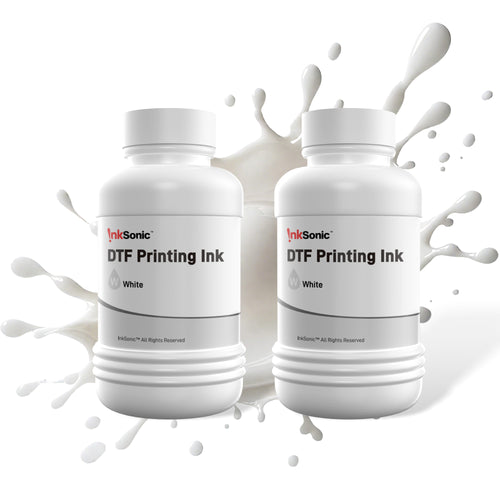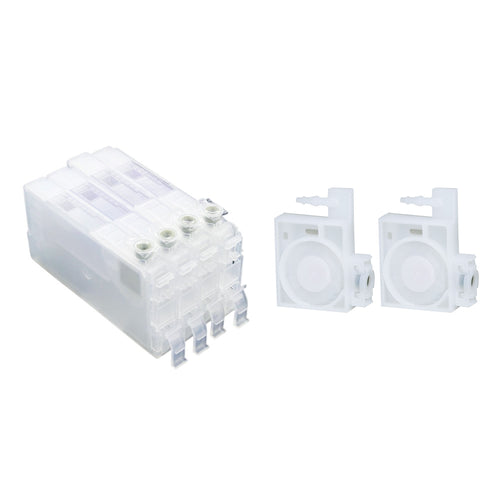UV DTF Printer
UV Direct-to-Film Printing – Professional Results at Your Fingertips!
Combining UV printing and Direct-to-Film (DTF) technology in a single device, UV DTF printer isn't just a tool — it's your creative partner for both flat and curved surfaces, hard or flexible materials, and personal or professional projects.
Whether you're printing high-definition decals for drinkware, phone cases, gift packaging, or home decor, UV DTF printing ensures vibrant color, long-lasting adhesion, and effortless application — no primer, no heat press, no limits.
Unlike flatbed UV printers limited by surface shape, or vinyl methods requiring multiple steps, the small UV DTF machine simplifies and speeds up the process — no contour cutting, no weeding, and no need for direct surface contact.
This category features printers that streamline the process with integrated lamination, instant UV curing, and printhead protection, making it easier than ever to bring your ideas to life.
Upgrade your printing game today—discover the best UV DTF machine and bring your designs to life with unmatched color, durability, and efficiency.
Advantages of UV Direct-to-Film Transfers
Multi-Material Compatibile: Works well with glass, metal, wood, plastic, and ceramic.
No Primer Required: Print as is without primer, unlike traditional UV printing.
High-Definition & Long-Lasting Images: Vivid colors, scratch-resistant, and fade-resistant for long-term durability.
Compatible with Irregular Surfaces: Ideal for curved or irregular surfaces, which opens up more product possibilities.
Applications of DTF UV Machine
For Personalized Products: DTF UV machine delivers vibrant colors and intricate designs, making it suitable for common products such as phone cases, gift boxes, and cups. It fulfills your creative decoration needs.
For Functional Decor: UV DTF decals/stickers are also used for functional purposes such as labeling and decoration. It may be placed on laptops, helmets, or even home appliances, combining function and beauty.
Design Tips & Inspiration
One of the best advantages of possessing a UV DTF decal printer is the convenience it provides you to create professional-quality designs with ease. Whether producing a one-time custom gift item or printing out dozens for clients, the right design choices will have a significant impact on your completed product's look and feel. Some tips and creative ideas follow to help you get started:
Optimal File Types & Resolution
To ensure crisp and professional results, always prepare your artwork with the correct specifications:
-
File Format: Use PNG files with transparent backgrounds for designs that need to blend seamlessly onto surfaces like glass, acrylic, or stainless steel. For vector logos or text, SVG or PDF files are ideal.
-
Resolution: Aim for 300 dpi (dots per inch). This resolution ensures sharp lines and vibrant detail even when printed at larger sizes.
-
Color Profiles: Stick to CMYK color mode for print accuracy. UV printers, including an acrylic business UV DTF printer, render CMYK inks best, ensuring what you design on screen matches your final transfer.
Best Color Combinations
Colors can make or break your design. Since UV inks are naturally vibrant and glossy, you can take advantage of bold contrasts:
- High Contrast: Color light hues against dark grounds (white underlays with neon hues on black mugs).
- Metallic Effects: Place transparent spots to enable metallic cups or glass surfaces to be seen beneath.
- Brand Consistency: For business usage, use color sets in harmony with corporate identity—UV DTF is suitable for precise copy jobs of logos.
- Seasonal Palettes: Red and green for Christmas, pastel shades for weddings, or boisterous team colors for sports wear.
Inspiration Ideas for Every Occasion
The versatility of a UV DTF transfer printer makes it easy to branch into countless product niches. Here are some creative applications:
- Seasonal Cups & Tumblers - As in, holiday mugs, tumblers for Halloween, wine glasses for Valentine's Day, etc. with quotes and illustrations for the seasons.
- Wedding Gifts - Customized Champagne Flutes, acrylic decorations, or gift boxes with the couple's initials or wedding date.
- Business Branding - Logo stickers, branded drinkware, or giveaway items for events. Seasly when using an acrylic business UV DTF printer to maintain professionalism and branding.
- Sports Team - Water bottles, tumblers, fan gear - all with team logos, mascots, and player numbers.
- Home & Lifestyle Decor - Custom storage jars, decorative glass/ceramic, or small furniture pieces, decorated with patterned decals.
By combining the technical side of preparations (file type, resolution and color managment) with some ideas for design, you gain a full benefit of a UV DTF printer. The result? Products that stand out in quality, durability, and design impact.
How to Use UV DTF Transfer Printer
1. Pattern Printing: The UV DTF cup wraps printer first prints your design on to special film (Film A) and applies a coat of UV-curable adhesive.
2. UV Curing: Ultraviolet light then quickly cures the ink, and the design with good adhesion is created.
3. Lamination: Film B (the backing film) is subsequently laminated over Film A, and the design receives its adhesive backing.
4. Transfer Application: Apply the decal/sticker onto the subject.
Why Choose UV DTF Printing?
|
Feature |
Advantage |
|
Multi-Material Compatible |
Works on glass, metal, wood, plastic, ceramic, and more |
|
No Primer Needed |
Print directly without extra prep |
|
High-Definition & Durable |
Vivid colors, scratch- and fade-resistant |
|
Curved or Irregular Surfaces |
Prints on items that flatbed printers cannot handle |
|
Fast & Efficient |
Simplifies workflow with integrated lamination and UV curing |
Unlike flatbed UV printers or vinyl methods that require multiple steps, a small UV DTF machine streamlines the process—no contour cutting, no weeding, and no direct surface contact required.
| Method | How It Works | Limitations | Best Suited For | Why UV DTF Wins |
|---|---|---|---|---|
| UV DTF Printing | Prints full-color designs with UV ink onto AB transfer film, then applies directly to cups. | Requires UV DTF printer & film supplies. | Custom cups, tumblers, glassware, coated plastics, and small-batch products. | Works on curved & irregular surfaces, vibrant colors, no heat press or coating needed. |
| Sublimation Printing | Uses heat + sublimation ink to infuse designs into polyester-coated surfaces. | Requires polyester-coated blanks; only works with light-colored items. | T-shirts, mugs, sublimation-ready tumblers. | UV DTF doesn’t need special coatings and works on a wider range of materials. |
| Vinyl Cutting | Cuts designs from adhesive vinyl sheets, which are then weeded and applied by hand. | Requires manual weeding; less durable; can peel over time. | Simple lettering, one-color designs, decals. | UV DTF prints full-color, no weeding, more durable & waterproof. |
| Direct UV Printing | UV printer prints directly onto flat or cylindrical items with UV ink curing. | Limited on curved or uneven surfaces; larger printers are costly. | Flat items, signage, phone cases. | UV DTF transfers easily wrap around cups without distortion, at a lower cost. |
How UV DTF Printing Works
-
Pattern Printing – The printer applies your design to special film (Film A) with UV-curable adhesive.
-
UV Curing – Ultraviolet light instantly cures the ink, creating a design with strong adhesion.
-
Lamination – Film B is laminated over Film A, giving your design a durable adhesive backing.
-
Transfer Application – Apply the decal/sticker onto your chosen surface.
Tip: UV DTF printing works on a wide range of surfaces, including curved mugs, phone cases, and decorative items.
Why Choose InkSonic's UV DTF Machine for Stickers
When it comes to UV DTF prints, the InkSonic VF13 stands out as a top-tier and best UV DTF machine for stickers for both professionals and hobbyists.
With user-friendliness and superior output in mind, the VF13 offers a variety of defining features:
2-in-1 Printing and Lamination: The VF13 combines printing and lamination into one device. With the introduction of UV light as a means of instant curing and heat-roller lamination, it prints crystal-clear stickers directly, reducing your workflow and saving precious space.
Single Printhead, Double the Speed: Equipped with a high-speed Epson DX7 printhead, the VF13 delivers unparalleled performance at 8ft²/h. It prints ultra-fine details with a 1440 dpi resolution, meeting different design requirements without compromising speed.
Trusted Printhead Protection: The printer boasts a 3-triangle printhead protection system comprising accurate suction, smooth-gliding rails, and collision sensors. Such a frame ensures stable paper feeding, smooth carriage movement, and guarding against potential collisions.
Space-Saving, Silent, and Mobile: Small and lightweight, the VF13 can comfortably fit into home or office settings. It is quiet in operation and sports a heavy-duty base and four silent casters for effortless mobility and arrangement wherever needed.
All the Support and Supplies You Need — from One Source
At InkSonic, we understand that choosing the right UV DTF stickers printer is only the first step. What really counts is the knowledge that we’ll be backed up with supplies and support to keep our business running well beyond our first run. Of course, not every creative is eager to dive headfirst into a new printing technology – not that they don’t believe in the results, but rather questioned about maintenance, supplies and who provides technical support once they’ve purchased. That’s why InkSonic goes beyond selling printers. We partner with you at every stage of your printing journey.
Every InkSonic UV DTF stickers printer is backed by full after-sales support and a complete range of certified supplies for reliable, professional-standard output. We provide everything you require to get started, operate, and maintain your machine, and print rich, durable prints on every project.
-
Reliable Supplies Always in Stock
From A-B transfer films and premium UV DTF inks to cleaning solutions, printhead maintenance kits, and capping stations — InkSonic offers only compatible, high-performance supplies engineered for our printers. This guarantees reliable color reproduction, smooth ink flow, and excellent film adhesion every time. -
Quick, Professional Technical Assistance
Our expert support team is available online to guide you through printer setup, software configuration, and troubleshooting. Whether it’s color misalignment, film feeding, or adhesion tuning, you’ll always have fast, friendly help when you need it most. -
Step-by-Step Training & Learning Resources
To turn you into a master of your printer, we offer you step-by-step guides, calibration techniques, and maintenance videos. They assist you in attaining the best productivity, increasing the life span of your printer, and attaining perfect output quality without relying on third-party service experts. -
Warranty Coverage & Readily Available Replacement Parts
Each InkSonic digital printer includes warranty protection for essential parts such as the mainboard, printhead (under specific circumstances), and mechanical parts. Should you ever require replacement parts, we carry inventory and make them ready for immediate shipment to minimize downtime and maintain your business. -
Global Logistics, Local Care
With a growing network across the U.S., Europe and Asia, InkSonic delivers movies, inks and accessories straight to your door fast. Our responsive customer service is available around the world and is ready to assist you no matter what time zone you reside in.
At InkSonic, we’re not just your equipment provider — we’re your printing partner. From premium materials to expert advice, we make sure every part of your UV direct-to-film experience stays seamless, supported, and profitable.
DTF UV Machine Maintenance Tips
1. Daily Maintenance of Printhead
Before work:
Test the print head to ensure that the ink flows smoothly and clean the print head if necessary.
After work:
Test the print head and save the test ink strips for comparison the next day.
Place the print head on the ink pad to prevent clogging caused by ink drying.
2. Keep Machine in a Clean State
Wipe the printer surface clean of dust and residue.
Keep the working area clean to prevent contamination and damage to printer components.
3. Storage and Maintenance of Supplies
AB film storage: Please place in a dry and cool place, avoid direct sunlight, and handle carefully when placing to avoid moisture. Please check the film before printing to ensure that the film is dry, smooth and wrinkle-free.
Ink storage: Keep in dark and check the ink regularly to maintain fluidity and quality. Low-capacity ink is best for low-volume printing to minimize the likelihood of extended exposure of the ink.
Ink must not be left uncovered in contact with the air for too long a time. Thus, after use, kindly close the ink bottle and store it in the dark and cold.
Check container seals regularly for damage
Regardless of the precautions, issues like smudges of ink, fuzzy prints, color inaccuracy, creased film, and poor adhesion may sometimes arise in UV DTF printing. When they do, it is better to stay calm, give yourself some time, and diagnose logically. Usually, the cause of the issue lies either in hardware or software.
Software Inspection
|
Optimization |
Optimization Techniques |
|
Print Resolution |
Adjust the print resolution to maintain a balance between print speed and quality. The resolution needs to be high in order to brighten up the image but lower the print speed. |
|
Ink Volume |
Use small quantities of ink to prevent bleeding and deliver uniform prints. Use ink to achieve the required color density. |
|
Curing Temperature & Time |
Balance cure time or temperature to improve adhesion of the ink to the material and lengthen the life of the print. |
|
Mechanical Adjustments |
Regularly check and maintain the printer's moving components, such as the print head, carriage, and film feed system, in good working condition. |
Hardware Screening
|
Common Issues |
Potential Causes |
Troubleshooting Steps |
|
Print Color Lines |
Foreign objects scratching the image Poor print head condition
|
1. Check if there are foreign objects on the platform. 2. Keep and clean the print head clean so the nozzles are free. |
|
Blurred Image |
Inconsistent film feed; Mechanical issues |
1. Check and align the print head to be in the right position. 2. Improve film loading and tensioning to prevent film misalignment. 3. Check and repair the printer components to eliminate mechanical failures. |
|
Color Inconsistency |
Inaccurate color profile; Ink shortage; Mixing colors - a print head condition |
1. Verify and update the color management profile to ensure proper color settings. 2. Refill ink to avoid missing colors. 3. Calibrate the printer regularly to produce accurate color printing. |
|
Film Wrinkling |
Improper film loading; Tension issues in the film path; Environmental factors (humidity) |
1. Follow the film loading guidelines to ensure proper film placement. 2. Position film feed guides and tensioners properly to keep them at the right tension. 3. Control environmental conditions so that temperature and humidity are in order. |
|
Poor Adhesion |
Insufficient ink adhesion Incorrect coating application Material incompatibility Low heat press temperature and short time |
1. Ensure the film surface is suitably prepared and coating is applied uniformly. 2. Use high-quality film designed specifically for UV DTF. 3. Adjust ink coverage and curing settings to ensure good adhesion with the film. 4. Wait for the heat roller to reach the appropriate temperature before printing and set the correct speed. |
|
White Ink Issues |
Clogged white ink nozzles Inconsistent white ink flow Pigment sedimentation in the ink |
1. Clean and unclog the white ink print head to ensure smooth ink flow. 2. Regularly stir and circulate the white ink to prevent sedimentation. 3. Use specialized maintenance products for white ink to maintain its quality. |
How to Remove Transfer Patterns on Hard Surfaces?
Be it for some temporary event for which the sticker was used, or you just put it incorrectly, or perhaps it's damaged; here's a comprehensive guide to help you get it off easily:
Method 1: Hot Water
Step 1: Soak the glass with a UV DTF decal in hot water at about 80° C for 5 to 10 minutes; this can warm up the adhesive and weaken its bond with the surface.
Step 2: With the help of a plastic scraper, peel the whole UV DTF sticker from the glass and avoid scratching.
Step 3: Spray any remaining adhesives on the surface with isopropyl alcohol or even an adhesive remover until it becomes dissolved.
Step 4: Clean the surface completely and let it dry with a clean dry towel.
Method 2: Hair Dryer / Heat Gun
Step 1: Heat the sticker with the heat gun carefully without heating the surface beyond its safe operating temperature.
Step 2: Heat the adhesive and gently pry it away with a plastic scraper.
Step 3: Apply isopropyl alcohol or adhesive remover to any residue remaining.
Step 4: Clean the surface with a soft, dry cloth.
Turn UV DTF Printing Into a Business
Owning a UV DTF printer isn’t just about creativity—it’s a business opportunity.
-
Having a printer is more than a creative outlet – it’s a business opportunity.
-
Low start up costs are available to hobbyists and entrepreneurs because affordable printers exist.
-
High demand exists for personalized gifts, custom merchandise, and orders in your local area.
-
Flexible business model, you can start as a side hustle from home, or commit fully as a business you run yourself.
With just a few bulk orders, your printer can start paying for itself while building a brand or side business.
FAQ
Q: What surfaces can the prints transfer on?
A: Glass, metal, wood, plastic, ceramic, and curved surfaces.
Q: How long do stickers last?
A: With proper curing, stickers are scratch- and fade-resistant for years.
Q: Can I run a small business with UV DTF printers?
A: Yes! Low startup costs and high demand make UV DTF printers ideal for entrepreneurs.
Q: What makes UV Direct-to-Film different from regular DTF or vinyl printing?
A: UV DTF combines direct-to-film printing with UV curing, to produce rapid, multi-material, versatile print without primer or contour cutting.
Q: Are UV DTF cup wraps dishwasher safe?
UV DTF prints are super durable and scratch resistant, as well as waterproof. Although the prints are very durable, for the best longevity, it is always advisable to hand wash. Repeated exposure to the dishwasher cycles, particularly with high heat, may gradually weaken the adhesive.
Q: How do I avoid bubbles / wrinkles applying UV DTF wraps?
Ensure the surface is clean, smooth and oil free prior to applying the prints. Prep the cup with isopropyl alcohol, then with a squeegee or scraper, press firmly on the film in circular motion beginning from the center and then pushing the film outward. If applied slowly and evenly, you will avoid bubbles.
Q: Can I sell transfers instead of finished products?
Yes! Many entrepreneurs sell ready-to-apply UV DTF transfers to other DIY enthusiasts. This is a great business model if you don’t want to handle physical products like cups and tumblers but still want to profit from your designs.
Q: How should I store unused AB film and transfers?
Keep films and pre-printed transfers in a cool, dry place away from direct sunlight. Store them in sealed plastic sleeves or boxes to avoid dust.
Q: Do UV DTF wraps work on all types of cups and tumblers?
They work best on smooth, hard surfaces like stainless steel tumblers, glass, ceramics, and coated plastics. They may not adhere well to silicone, textured, or powder-coated items without special prep.
Q: Is special software needed for?
Yes, most require RIP software to handle color accuracy and white ink layering. Inksonic printers, for example, include beginner-friendly RIP solutions to ensure professional-quality prints.
Upgrade Your Printing Game Today!
Stop relying on expensive local shops—bring professional UV DTF printing into your home or business. Explore our selection of UV DTF printer, start creating vibrant, long-lasting decals, and unlock your full creative potential.

































